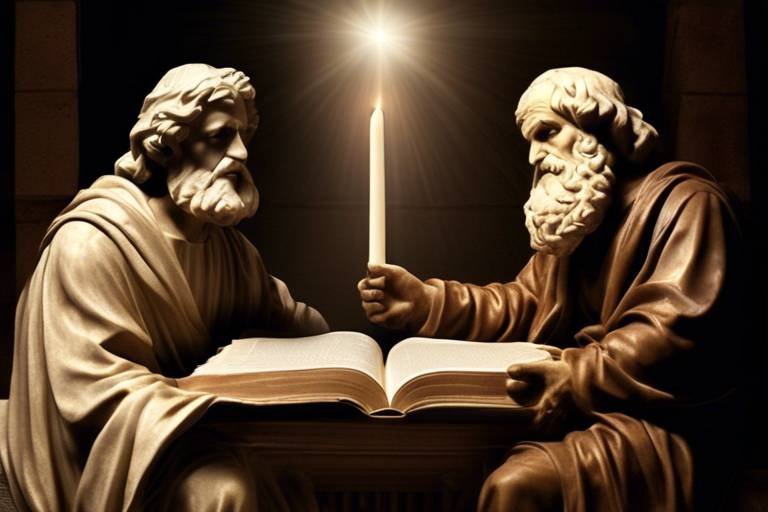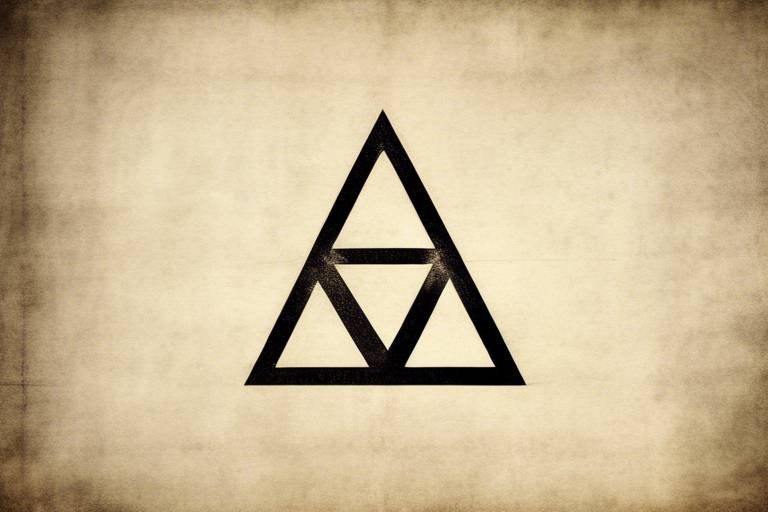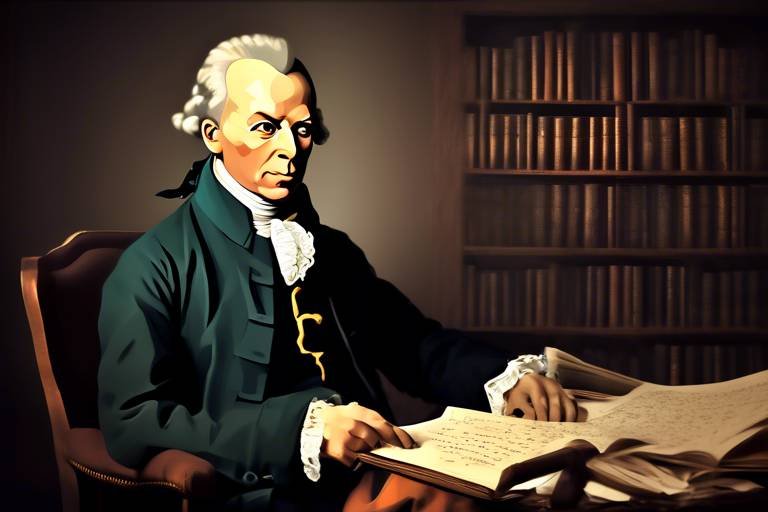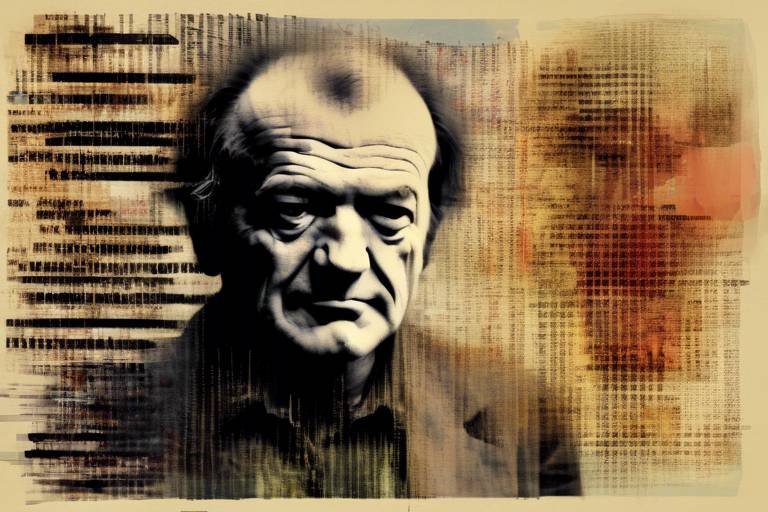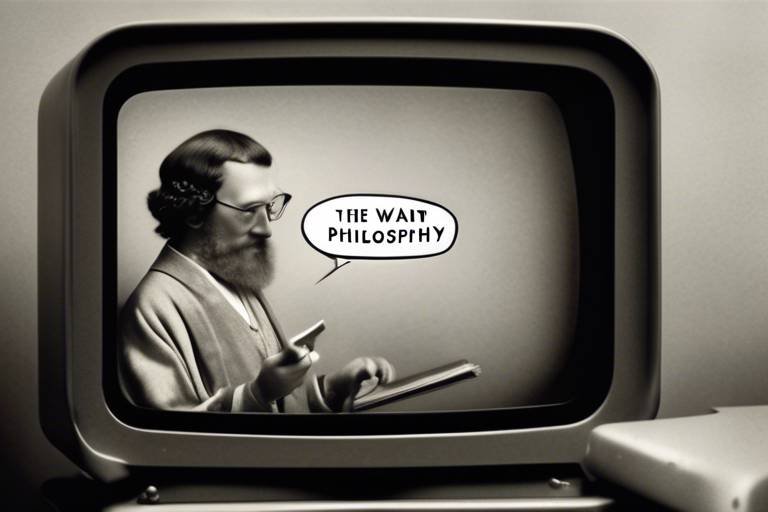How is Philosophy Connected to Math?
Have you ever pondered the deep and intricate relationship between philosophy and mathematics? It’s like a dance where each partner influences the other's movements, creating a beautiful harmony that shapes our understanding of both disciplines. At first glance, they might seem worlds apart—one is often seen as an abstract realm of numbers and formulas, while the other delves into the profound questions of existence and knowledge. However, when you peel back the layers, you’ll discover that the connections are not only significant but also essential for grasping the very nature of reality.
Philosophy provides the framework through which we can scrutinize the assumptions and foundations of mathematics. For instance, when mathematicians assert that a particular theorem is true, it raises questions about the nature of truth itself. Is mathematical truth an objective reality, or is it merely a construct of human thought? This is where philosophical inquiry becomes crucial. By examining the principles that underpin mathematical reasoning, we can better understand the implications of mathematical claims and the validity of our conclusions.
Moreover, the dialogue between these two fields has led to groundbreaking ideas and theories. Think of historical figures like Plato, who proposed that mathematical entities exist in a realm of their own, independent of human minds. This notion—known as mathematical Platonism—suggests that numbers and shapes have a reality that transcends our physical world. On the other hand, philosophers like Immanuel Kant argued that our understanding of mathematics is shaped by the innate structures of human cognition. This divergence in thought illustrates how philosophy can challenge and enrich mathematical concepts, leading to a deeper exploration of what it means to know and understand mathematics.
As we delve further into this relationship, we’ll uncover various philosophical perspectives that shape our understanding of mathematics. From realism to nominalism and constructivism, each viewpoint offers unique insights into the existence and nature of mathematical objects. These discussions are not merely academic; they have real-world implications for how we approach mathematical education and practice. By engaging with these philosophical ideas, educators and students alike can foster a richer, more nuanced understanding of mathematics that goes beyond rote memorization of formulas.
In essence, the connection between philosophy and mathematics is a vibrant tapestry woven from threads of inquiry, logic, and existential questions. As we continue to explore this fascinating intersection, we invite you to reflect on your own experiences with mathematics and consider how philosophical ideas might have influenced your understanding. Are there moments when you’ve felt the weight of a mathematical truth? Or times when you’ve questioned the validity of a mathematical argument? These reflections can deepen your appreciation for the profound relationship between these two fields.
- What is the main connection between philosophy and mathematics?
Philosophy explores the foundational concepts of mathematics, questioning the nature of mathematical truth, existence, and the implications of mathematical reasoning. - Who are some key figures in the philosophy of mathematics?
Notable figures include Plato, who proposed mathematical Platonism, and Immanuel Kant, who emphasized the role of human cognition in understanding mathematics. - What are the different philosophical perspectives on mathematics?
Key perspectives include realism, nominalism, and constructivism, each offering unique insights into the nature of mathematical entities and their existence. - How does logic influence mathematics?
Logic provides the framework for mathematical proofs and reasoning, shaping our understanding of mathematical concepts and their relationships.

The Foundations of Mathematical Thought
The world of mathematics is not just a collection of numbers and formulas; it is deeply rooted in philosophical concepts that shape how we understand and engage with numbers. At its core, the foundations of mathematical thought are built upon a series of philosophical inquiries that question the very essence of mathematical truth. What does it mean for something to be mathematically true? Is there an objective reality to mathematics, or is it merely a human construct? These questions have intrigued thinkers for centuries and have led to the development of various foundational theories.
One of the most significant aspects of mathematical reasoning is logic. Logic serves as the backbone of mathematical proofs, ensuring that conclusions drawn from premises are valid. In essence, it is the language of mathematics. Without a solid understanding of logical principles, the entire structure of mathematics could crumble. Philosophers like Aristotle laid the groundwork for formal logic, which later influenced mathematicians such as Frege and Russell. Their works emphasized the importance of logical consistency and clarity in mathematical arguments, highlighting how philosophical insights can enhance mathematical rigor.
The implications of these foundational theories extend far beyond abstract thought. They affect how we teach mathematics, how we approach problem-solving, and even how we perceive mathematical truths. For instance, consider the debate surrounding the existence of mathematical objects. Are numbers and shapes real entities that exist independently of human thought? Or are they simply symbols we use to describe relationships and patterns? This debate is not just academic; it influences how educators present mathematical concepts to students. If one believes in the independent existence of numbers, teaching might focus on discovering these truths, while a more constructivist view might emphasize building mathematical knowledge through experience and interaction.
Additionally, the role of axiomatic systems cannot be overlooked. Axioms are the foundational statements accepted without proof, serving as the starting point for further reasoning. The famous mathematician David Hilbert aimed to establish a complete and consistent set of axioms for all of mathematics, which led to the development of formalism. This approach raised further philosophical questions about the nature of mathematical existence: if mathematics can be reduced to a set of axioms, what does that say about the reality of mathematical entities?
In summary, the foundations of mathematical thought are a rich tapestry woven from philosophical inquiry, logic, and axiomatic systems. These elements not only define the structure of mathematics but also challenge us to reflect on the nature of truth and existence within this discipline. As we continue to explore this intricate relationship, we gain deeper insights into both mathematics and philosophy, enriching our understanding of the world around us.
- What is the relationship between philosophy and mathematics?
Philosophy provides a framework for understanding the fundamental questions about the nature of mathematical truths, while mathematics offers a structured way to explore these philosophical ideas.
- How does logic influence mathematical thought?
Logic serves as the foundation for mathematical proofs, ensuring that conclusions are drawn from premises in a valid manner, thus enhancing the rigor of mathematical arguments.
- What are axioms, and why are they important?
Axioms are foundational statements accepted without proof that serve as the basis for further mathematical reasoning. They are crucial for establishing the structure of mathematical theories.

Philosophy of Mathematics
The is a fascinating field that probes into the very essence of mathematical entities, their existence, and their implications for our understanding of reality. At the heart of this philosophical inquiry lies the question: What is the nature of mathematical objects? Are they mere constructs of the human mind, or do they exist independently of our thoughts and perceptions? This debate has birthed several schools of thought, each offering unique perspectives on the existence and significance of mathematics in our world.
One of the most prominent views is mathematical realism, which posits that mathematical objects, such as numbers and shapes, exist in an abstract realm, much like physical objects exist in the tangible world. Proponents of this view argue that mathematical truths are discovered rather than invented, suggesting that there is an objective reality to mathematics that transcends human thought. This idea can be likened to a vast library filled with books that contain truths waiting to be uncovered; mathematicians, in this sense, are akin to explorers navigating through the shelves of this library.
On the flip side, we have nominalism, a perspective that challenges the existence of abstract mathematical objects. Nominalists argue that mathematical entities are simply names or labels we use to describe collections of things, rather than existing independently. This view emphasizes the role of language and symbols in mathematics, suggesting that our mathematical discourse is a reflection of our cognitive processes rather than a discovery of an external reality. Imagine mathematics as a game of chess: the pieces on the board (numbers and shapes) do not exist outside the game itself; they come to life only within the framework of the rules we create.
Another significant perspective is constructivism, which asserts that mathematical knowledge is constructed through mental processes and cannot be separated from the act of constructing it. Constructivists maintain that to claim the existence of a mathematical object, one must be able to provide a method for its construction. This viewpoint aligns closely with the idea that mathematics is not merely a passive reflection of reality but an active engagement with it. In this sense, mathematicians are like architects, building structures of knowledge brick by brick, ensuring that each piece is grounded in tangible processes.
Each of these philosophical perspectives shapes our understanding of mathematics in profound ways. For example, the implications of realism might lead one to view mathematical education as a journey of discovery, while nominalism might encourage a focus on the utility of mathematical language and symbols in solving real-world problems. Meanwhile, constructivism emphasizes the importance of hands-on experiences and the development of problem-solving skills in learning mathematics.
In conclusion, the philosophy of mathematics serves as a bridge linking abstract thought with tangible reality. It challenges us to consider not just what mathematics is, but how we engage with it and what it reveals about the world we inhabit. By exploring these diverse perspectives, we can gain a richer understanding of both mathematics and the philosophical inquiries that underpin it.
- What is the philosophy of mathematics? It is the study of the nature and implications of mathematical entities, examining their existence and the meaning behind mathematical truths.
- What are the main perspectives in the philosophy of mathematics? The main perspectives include mathematical realism, nominalism, and constructivism.
- How does philosophy influence mathematical practice? Different philosophical views shape how mathematicians approach problems, understand mathematical concepts, and engage in mathematical education.

Mathematical Platonism
Mathematical Platonism is a fascinating philosophical perspective that posits the existence of mathematical objects as independent entities, akin to the way physical objects exist in the world. Imagine a world where numbers, shapes, and abstract concepts float around in a realm of their own, untouched by human thought. This idea suggests that mathematical truths are discovered rather than invented, much like explorers uncovering hidden treasures in a vast ocean. This perspective raises profound questions about the nature of mathematical knowledge and truth, challenging us to consider: Are we merely observers of a pre-existing mathematical reality, or are we creators of our mathematical universe?
One of the core tenets of Mathematical Platonism is the belief in the **objective existence** of mathematical entities. For instance, the number 2 is not just a label we apply to a pair of objects; it exists in its own right, regardless of whether anyone is around to recognize it. This perspective provides a robust framework for understanding why mathematical statements can be universally valid, transcending cultural and temporal boundaries. Just think about how the Pythagorean theorem holds true regardless of where or when you are in the world; it’s a testament to the enduring nature of mathematical truths.
However, the implications of Platonism extend beyond mere existence. If mathematical objects exist independently, then it raises questions about the nature of mathematical knowledge. How do we come to know these truths? Are we tapping into a universal consciousness, or are we simply refining our understanding of a reality that is already there? This leads us to explore the relationship between mathematics and the **human mind**—a relationship that is both intimate and complex.
To illustrate this, let’s consider some key implications of Mathematical Platonism:
- Universality of Mathematics: The belief that mathematical truths are universal implies that they are not subject to personal or cultural biases.
- Objectivity: Mathematical Platonism supports the idea that mathematical truths exist independently of human thought, making them objective rather than subjective.
- Discovery vs. Invention: It emphasizes the notion that mathematicians are discoverers of truths rather than inventors of concepts.
Despite its appeal, Mathematical Platonism is not without its critics. Some argue that it leads to an **epistemological dilemma**: if mathematical entities exist in a realm beyond our physical world, how can we have knowledge of them? This question challenges the very foundation of mathematical practice and invites us to consider alternative views. Nevertheless, the allure of Platonism remains strong, as it offers a compelling narrative about the nature of mathematics that resonates with many mathematicians and philosophers alike.
In conclusion, Mathematical Platonism invites us to think deeply about the existence of mathematical entities and the nature of mathematical truth. It opens up a dialogue about how we perceive and interact with the abstract world of mathematics, encouraging us to ponder the profound mysteries that lie at the intersection of philosophy and mathematics.

Critiques of Platonism
While Mathematical Platonism presents a compelling argument for the existence of mathematical objects independent of human thought, it is not without its critics. One of the primary critiques is the question of ontological commitment. Critics argue that if mathematical entities exist in some abstract realm, then we must explain how humans can access or interact with these entities. This leads to a perplexing dilemma: how can something that is non-physical and non-empirical have any influence on our physical world? In essence, this brings us to the philosophical conundrum of how we can claim knowledge of these abstract objects.
Another significant critique comes from the perspective of nominalism. Nominalists argue that mathematical entities are merely names or labels we use to describe collections of objects or concepts. According to this view, mathematics does not discover truths about an abstract realm but rather creates a useful language for discussing relationships among real-world entities. This perspective challenges the Platonist notion of mathematical objects as discovered truths, suggesting instead that they are human inventions. If mathematics is merely a tool, then its truths cannot be said to exist independently of the human mind.
Furthermore, the implications of mathematical practice raise questions about the utility of Platonism. Critics point out that the practical application of mathematics in science and engineering often relies on formal systems rather than the existence of abstract mathematical objects. For instance, engineers use mathematical models to predict outcomes, but these models are not necessarily rooted in the existence of mathematical entities. Instead, they are based on empirical observations and practical applications, which calls into question the relevance of Platonism in real-world scenarios.
In addition to these critiques, there is the challenge of infinity. Platonism struggles to adequately explain the nature of infinite sets and their properties. The existence of infinite objects raises profound questions about their reality. Critics argue that if we accept the existence of infinite mathematical entities, we must also grapple with the implications of their paradoxes and contradictions, which can undermine the coherence of the Platonist view.
To summarize, the critiques of Platonism can be encapsulated in several key points:
- Ontological Commitment: Questions about how non-physical entities influence the physical world.
- Nominalism: The belief that mathematical entities are mere labels rather than independent truths.
- Practical Application: The reliance on formal systems in mathematics rather than abstract entities.
- Infinity: Challenges posed by the existence of infinite sets and their properties.
These critiques invite a deeper exploration of the nature of mathematics and its philosophical implications. They challenge mathematicians and philosophers alike to reconsider how we understand mathematical truth and existence, encouraging a dynamic dialogue between these two fascinating fields.
- What is Mathematical Platonism? It is the view that mathematical objects exist independently of human thought.
- What are the main critiques of Platonism? Critics question its ontological commitment, argue from a nominalist perspective, highlight the practical applications of mathematics, and challenge its handling of infinity.
- How does nominalism differ from Platonism? Nominalism holds that mathematical entities are human-made labels, while Platonism asserts their independent existence.

Support for Platonism
Support for mathematical Platonism is grounded in the notion that mathematical entities exist in an abstract realm, independent of human thought. This perspective asserts that numbers, shapes, and other mathematical objects are not merely constructs of the human mind but rather exist in a timeless, non-physical space. Advocates of Platonism argue that this view provides a robust framework for understanding the objectivity and universality of mathematical truths. For instance, consider the Pythagorean theorem: it holds true regardless of whether anyone is aware of it or whether it has been discovered. This universality suggests that mathematical truths are not contingent upon human cognition.
Moreover, Platonism offers a compelling explanation for the effectiveness of mathematics in the natural sciences. The fact that mathematical models can accurately describe physical phenomena raises questions about the nature of mathematical existence. If mathematics were merely a human invention, how could it so precisely reflect the workings of the universe? Platonists argue that this effectiveness points to the reality of mathematical entities existing in an abstract realm, which scientists tap into when developing theories and models.
Another strong argument in favor of Platonism is the consistency and coherence of mathematical systems. When mathematicians prove theorems, they often rely on established axioms and definitions that have been accepted across cultures and epochs. This consistency suggests a shared understanding of mathematical truths that transcends individual perspectives. For example, the concept of infinity is treated with remarkable uniformity in various mathematical frameworks, despite the cultural and historical differences among mathematicians. Such universal acceptance implies that these mathematical concepts have an existence that is not merely subjective.
Furthermore, the notion of mathematical beauty and elegance often cited by mathematicians can be interpreted as evidence for the Platonist view. Many mathematicians describe their work as uncovering hidden truths rather than creating new ones. This sentiment resonates with the idea that mathematics is a discovery process, where mathematicians explore an existing landscape of abstract entities. The aesthetic appreciation of mathematical proofs and theories—where simplicity and elegance are seen as indicators of deeper truths—reinforces the Platonist perspective that these entities exist independently of human thought.
In summary, the support for mathematical Platonism stems from its ability to explain the universality of mathematical truths, the effectiveness of mathematics in science, the consistency of mathematical systems, and the aesthetic qualities of mathematical discovery. These arguments collectively bolster the claim that mathematical objects inhabit a realm that is not contingent upon human existence, offering a robust framework for understanding the nature of mathematics itself.
- What is mathematical Platonism?
Mathematical Platonism is the philosophical view that mathematical entities exist independently of human thought, in an abstract realm.
- Why do people support Platonism?
Supporters argue it explains the universality of mathematical truths, the effectiveness of mathematics in science, and the aesthetic appreciation of mathematical proofs.
- What are some critiques of Platonism?
Critics argue against the existence of abstract entities and suggest alternative views such as nominalism or constructivism.

Constructivism vs. Formalism
When diving into the realm of mathematics, two philosophical approaches often come to the forefront: constructivism and formalistism. Each of these schools of thought offers a unique perspective on the nature of mathematical truths and the processes through which we arrive at them. Imagine constructivism as a hands-on workshop where you build your own mathematical structures from the ground up, while formalism resembles a well-organized library filled with rules and symbols that govern mathematical expressions. This distinction is crucial for understanding how different mathematicians and philosophers approach their work.
Constructivism posits that mathematical objects do not exist independently of our knowledge of them. In other words, a mathematical entity is only "real" if it can be constructed through a series of finite steps. This viewpoint emphasizes the importance of proofs and algorithms, as they provide the necessary framework to demonstrate the existence of mathematical concepts. For constructivists, a mathematical statement is only meaningful if there is a method to verify its truth. This leads to a more dynamic and interactive approach to mathematics, where the focus is on the processes of creation and discovery.
On the other hand, formalism treats mathematics as a system of symbols and rules. In this view, mathematics is akin to a game where the emphasis is placed on manipulating symbols according to established guidelines, regardless of their meaning. Formalists argue that the truth of a mathematical statement is determined by its adherence to these rules rather than by any intrinsic existence of the objects involved. This approach allows for a more abstract understanding of mathematics, where the focus is on the structure and relationships between symbols rather than their real-world implications.
The differences between constructivism and formalism can be summarized in the following table:
| Aspect | Constructivism | Formalism |
|---|---|---|
| Existence of Mathematical Objects | Only exist if they can be constructed | Exist as symbols within a system |
| Focus | Processes of construction and proof | Rules and manipulation of symbols |
| Truth | Dependent on verifiable methods | Dependent on adherence to formal rules |
Both constructivism and formalism have profound implications for mathematical practice and education. For instance, in a classroom setting, a constructivist approach may encourage students to explore mathematical concepts through hands-on activities, fostering a deeper understanding of the subject. Conversely, a formalist perspective might prioritize the development of skills in manipulating symbols and following established procedures, which can be equally valuable in certain contexts.
Ultimately, the debate between constructivism and formalism raises essential questions about the nature of mathematics itself. Is mathematics a discovery of existing truths, or is it a creation of human thought? This philosophical inquiry not only shapes how we teach and learn mathematics but also influences the broader understanding of what mathematics represents in our world.
- What is the main difference between constructivism and formalism?
Constructivism focuses on the existence of mathematical objects through construction and proof, while formalism emphasizes the manipulation of symbols according to established rules. - How do these philosophies impact mathematical education?
Constructivism encourages hands-on learning and exploration, while formalism prioritizes skill development in symbol manipulation and following procedures. - Can both approaches coexist in mathematics?
Yes, many mathematicians and educators find value in both approaches and incorporate elements of each into their work.

The Role of Logic in Mathematics
Logic is the backbone of mathematics, acting as the framework that supports all mathematical reasoning and proofs. Without logic, mathematics would be a chaotic jumble of numbers and symbols, lacking coherence and meaning. Think of logic as the language that mathematics speaks; it provides the rules and structure necessary for conveying complex ideas clearly and effectively. Just like a well-constructed building needs a solid foundation, mathematics relies on logical principles to ensure that its structures are sound and reliable.
At its core, logic helps mathematicians to derive conclusions from premises. It allows them to formulate proofs that can be universally accepted, establishing truths that stand the test of time. For instance, the famous Pythagorean theorem is not just a statement about right triangles; it is a conclusion derived from logical reasoning based on axioms and previously established theorems. Thus, the relationship between logic and mathematics is not merely supportive; it is fundamentally intertwined.
Moreover, philosophical inquiries into logic have a profound impact on how mathematical concepts are understood. The exploration of different logical systems, such as classical logic, intuitionistic logic, and modal logic, reveals the nuances in mathematical reasoning. Each system offers a unique perspective on the nature of truth and validity in mathematics, leading to varied interpretations and applications. For example, while classical logic accepts the principle of excluded middle (every statement is either true or false), intuitionistic logic does not, which has significant implications for mathematical proofs and constructions.
Modal logic, which introduces the concepts of necessity and possibility, also plays a crucial role in mathematics. It allows mathematicians to discuss not just what is true, but what could be true under certain conditions. This adds a layer of depth to mathematical reasoning, enabling discussions about hypothetical scenarios and their implications. For instance, in set theory, one might ask whether a particular set could exist under different axiomatic systems, leading to rich philosophical debates about the nature of mathematical objects.
To further illustrate the interplay between logic and mathematics, consider the following table that highlights key logical principles and their mathematical applications:
| Logical Principle | Mathematical Application |
|---|---|
| Law of Non-Contradiction | Ensures that a statement and its negation cannot both be true, foundational for proofs. |
| Modus Ponens | A form of argument that allows one to derive a conclusion from a conditional statement and its antecedent. |
| Universal Quantification | Used in proofs to assert that a property holds for all elements in a set. |
In addition to these logical principles, the role of set theory cannot be overstated. Set theory serves as a foundational framework for much of modern mathematics, and its axioms are deeply rooted in logical reasoning. Philosophers and mathematicians alike engage in heated debates regarding the axioms of set theory, particularly concerning the nature of infinity and the existence of certain sets. These discussions not only shape mathematical practices but also influence educational approaches, as understanding logic is essential for students learning mathematics.
Ultimately, the relationship between logic and mathematics is a dynamic and evolving one. As new mathematical concepts emerge and new logical systems are developed, the dialogue between these two fields continues to deepen. This interplay not only enriches our understanding of mathematics but also enhances the philosophical inquiries that drive both disciplines forward.
- What is the importance of logic in mathematics? Logic provides the necessary framework for mathematical reasoning, ensuring that conclusions drawn from premises are valid and reliable.
- How does modal logic differ from classical logic? Modal logic introduces the concepts of necessity and possibility, allowing for discussions about what could be true in addition to what is true.
- Why is set theory significant in mathematics? Set theory underpins much of modern mathematics and is essential for understanding the relationships between different mathematical objects.

Modal Logic and Mathematics
Modal logic, a fascinating branch of logic, delves into the concepts of necessity and possibility, offering a unique lens through which we can view mathematical reasoning. Imagine a world where mathematical truths are not just static entities but dynamic concepts that can shift based on context and circumstance. This is the essence of modal logic, which asks profound questions: What does it mean for a mathematical statement to be necessarily true? Can something be possible yet not actual? These inquiries are not merely academic; they reshape our understanding of mathematics itself.
At its core, modal logic introduces operators that allow us to express statements about necessity (often denoted as □) and possibility (denoted as ◇). For instance, when we say "It is necessary that 2 + 2 4," we are asserting a truth that holds in all conceivable worlds. Conversely, "It is possible that there exists a prime number greater than 100" reflects a statement that, while not guaranteed, is plausible within our mathematical framework. This duality enriches our engagement with mathematical concepts, pushing us to consider not only what is true but also what could potentially be true under different circumstances.
One of the most intriguing aspects of modal logic in mathematics is its application in understanding mathematical proofs. Traditional proofs often focus on establishing the truth of a statement in a specific context. However, by incorporating modal logic, mathematicians can explore the broader implications of their findings. For example, consider the statement: "If a number is prime, then it cannot be even." Using modal logic, we can analyze this statement across various possible worlds, examining scenarios where the definition of prime might shift or where new mathematical constructs could emerge.
Furthermore, modal logic plays a crucial role in the development of mathematical theories, particularly in areas like set theory and topology. By applying modal concepts, mathematicians can investigate the nature of mathematical objects and their relationships in a more nuanced way. For instance, in topology, we can ask whether a particular property of a space is necessarily true in all topological contexts or merely possible in some. This exploration opens up a wealth of questions about the structure and behavior of mathematical entities.
To illustrate the interplay between modal logic and mathematics, let's consider a simple table that outlines how modal operators can be applied to various mathematical statements:
| Statement | Necessarily True (□) | Possibly True (◇) |
|---|---|---|
| All even numbers are divisible by 2. | Yes | No |
| There exists a largest prime number. | No | Yes |
| A circle has a constant radius. | Yes | No |
This table highlights how modal logic can challenge our assumptions about mathematical truths. It invites us to consider not only what we know but also the boundaries of our knowledge. By embracing the nuances of necessity and possibility, we can deepen our understanding of mathematics and its philosophical implications.
In conclusion, the intersection of modal logic and mathematics is a rich and vibrant area of inquiry. It encourages us to think beyond the confines of traditional mathematical reasoning, embracing a more dynamic and flexible approach to understanding mathematical truths. As we continue to explore these connections, we pave the way for new insights and discoveries that could reshape the very foundations of mathematics itself.
- What is modal logic? Modal logic is a type of logic that deals with concepts of necessity and possibility, allowing for a more nuanced exploration of truth in various contexts.
- How does modal logic apply to mathematics? Modal logic helps mathematicians analyze the implications of mathematical statements across different scenarios, enhancing our understanding of mathematical truths.
- Can you give an example of modal operators in use? An example would be stating "It is necessary that 2 + 2 4," which asserts a truth that holds in all possible worlds.
- Why is the study of modal logic important? It challenges traditional views of mathematical reasoning and encourages a broader perspective on the nature of mathematical objects and relationships.

Set Theory and Philosophy
Set theory, often considered the bedrock of modern mathematics, serves as a fascinating intersection between mathematics and philosophy. At its core, set theory deals with the concept of collections of objects, which can be anything from numbers to more abstract entities. This seemingly simple idea opens a Pandora's box of philosophical questions. For instance, what does it mean for a set to exist? Are sets merely human constructs, or do they have an independent existence? This inquiry not only challenges our understanding of mathematical objects but also pushes us to reconsider the nature of reality itself.
One of the most significant philosophical implications of set theory is its treatment of infinity. In mathematics, infinity is not just a concept; it is a fundamental aspect of set theory that leads to intriguing paradoxes and discussions. For example, consider the set of all natural numbers. This set is infinite, yet we can still talk about its properties and operations. The philosophical ramifications of this are profound. How can something that is infinite be treated as a complete entity? This question has puzzled philosophers and mathematicians alike, leading to various interpretations and theories.
Moreover, set theory introduces us to various types of infinities, such as countable and uncountable infinities, famously illustrated by Cantor's diagonal argument. This argument not only demonstrates that some infinities are larger than others but also raises questions about the nature of mathematical existence. Are all infinities equally real, or do some hold more mathematical significance than others? Such inquiries highlight the philosophical richness embedded within set theory.
In addition to its implications on infinity, set theory also challenges traditional notions of logic and truth in mathematics. The axioms of set theory, such as Zermelo-Fraenkel set theory with the Axiom of Choice (ZFC), are not universally accepted. Instead, they are subject to philosophical scrutiny. Some argue that these axioms are merely conventions, while others maintain that they reflect deeper truths about the mathematical universe. This debate leads us to consider the nature of mathematical axioms themselves: Are they discovered truths about an objective mathematical reality, or are they human-made rules that simply help us navigate mathematical landscapes?
Furthermore, set theory has significant implications for the philosophy of language and meaning. When we talk about sets, we are often using language that implies a certain level of understanding and agreement on what those sets entail. This raises questions about the relationship between language and mathematical truth. Are the words we use to describe sets merely labels, or do they carry deeper meanings that shape our understanding of mathematical concepts? This interplay between language, thought, and mathematical entities is a rich area of philosophical inquiry.
In conclusion, set theory is not just a mathematical framework; it is a profound philosophical exploration that challenges our understanding of existence, infinity, and truth. By examining the philosophical implications of set theory, we gain deeper insights into the nature of mathematics itself and its relationship with the world around us. The discussions surrounding set theory continue to evolve, inviting both mathematicians and philosophers to engage in a dialogue that bridges these two seemingly disparate fields.
- What is set theory? Set theory is a branch of mathematical logic that studies sets, which are collections of objects. It serves as a foundational framework for modern mathematics.
- Why is set theory important in philosophy? Set theory raises philosophical questions about existence, infinity, and the nature of mathematical truth, prompting deep inquiries into the foundations of mathematics and reality.
- What are the implications of infinity in set theory? Set theory introduces different types of infinities, leading to paradoxes and discussions about the nature of mathematical entities and their properties.
- How do set theory and logic intersect? The axioms of set theory influence logical reasoning in mathematics, prompting philosophical debates about the nature of truth and the validity of mathematical statements.
Frequently Asked Questions
- How does philosophy influence mathematical thought?
Philosophy plays a crucial role in shaping mathematical thought by providing a framework for understanding the foundations and implications of mathematical concepts. Philosophical inquiries challenge mathematicians to consider the nature of mathematical truth, the existence of mathematical objects, and the logical structures that underpin mathematical reasoning.
- What are the main philosophical perspectives on mathematics?
There are several key philosophical perspectives on mathematics, including realism, which posits that mathematical entities exist independently of human thought; nominalism, which denies the independent existence of mathematical objects; and constructivism, which emphasizes the importance of constructing mathematical knowledge through specific processes. Each perspective offers unique insights into the nature of mathematics and its relationship with reality.
- What is mathematical Platonism?
Mathematical Platonism is the view that mathematical objects, such as numbers and shapes, exist independently of human thought and language. This perspective suggests that mathematical truths are discovered rather than invented, leading to discussions about the nature of reality and the objectivity of mathematical knowledge across cultures and eras.
- What are some critiques of mathematical Platonism?
Critiques of mathematical Platonism often focus on the challenge of explaining how abstract mathematical entities can interact with the physical world. Critics argue that if mathematical objects exist independently, it raises questions about how we can have knowledge of them. Alternative views, such as nominalism, propose that mathematical concepts are merely useful fictions created by humans.
- What arguments support mathematical Platonism?
Supporters of mathematical Platonism argue that it provides a compelling explanation for the objectivity and universality of mathematical truths. They point out that mathematical principles hold true regardless of cultural or temporal contexts, suggesting that these truths exist in a realm beyond human influence and understanding.
- How do constructivism and formalism differ in mathematics?
Constructivism emphasizes the idea that mathematical knowledge is constructed through specific processes and that mathematical entities do not exist unless they can be explicitly constructed. In contrast, formalism focuses on the manipulation of symbols according to established rules, treating mathematics as a game with its own set of rules rather than a reflection of reality.
- What role does logic play in mathematics?
Logic is fundamental to mathematics as it provides the structure and rules for mathematical reasoning. Philosophical inquiries into logic help clarify the validity of mathematical proofs and the relationships between different mathematical concepts, ensuring that conclusions drawn are both sound and reliable.
- How does modal logic intersect with mathematics?
Modal logic introduces concepts of necessity and possibility, which can significantly influence mathematical reasoning. By examining different scenarios and their potential outcomes, modal logic allows mathematicians to explore the implications of various mathematical statements and the nature of mathematical truths in a broader context.
- What are the philosophical implications of set theory?
Set theory is foundational to modern mathematics, and its philosophical implications are profound. Debates surrounding the axioms of set theory, such as the nature of infinity and the existence of different sizes of infinity, challenge our understanding of mathematical existence and reality, prompting deep philosophical questions about the nature of mathematical entities.





